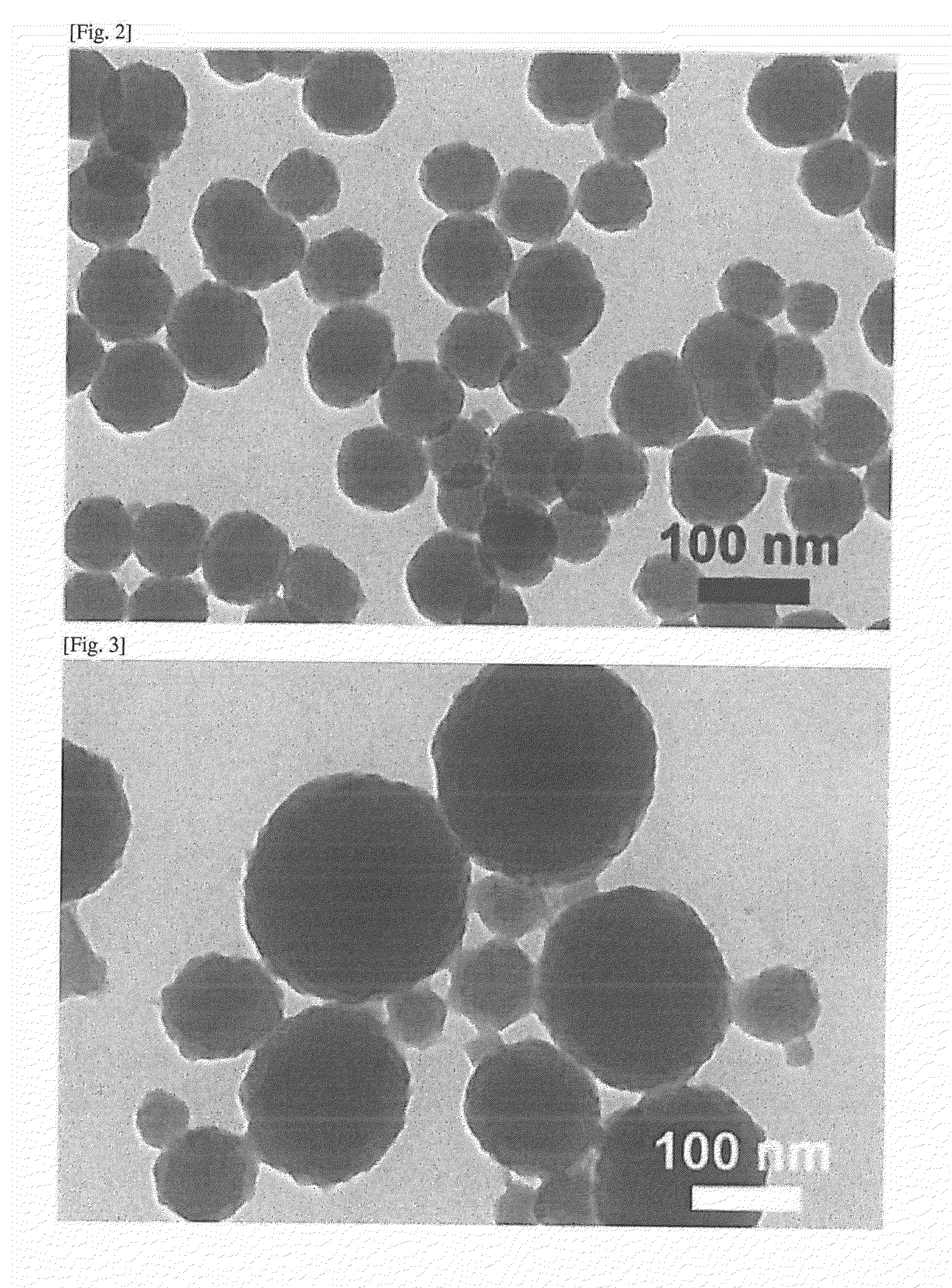Contrast-Enhancing Agent for Nuclear Magnetic Resonance Imaging Comprising Melanin Nanoparticles Stably Dispersed in Water
- Summary
- Abstract
- Description
- Claims
- Application Information
AI Technical Summary
Benefits of technology
Problems solved by technology
Method used
Image
Examples
example 1
Preparation of Melanin Nanoparticles
[0058]1) Example 1-1 (MelNPs)
[0059]180 mg of dopamine hydrochloride (Aldrich Chemical) was dissolved in 90 mL of deionized water. 760 μl of 1 N NaOH solution was added to the dopamine hydrochloride solution at 50° C. with vigorous stirring. When NaOH was added, the solution immediately changed to light yellow, and gradually to deep brown. After reaction for 5 hours, melanin nanoparticles were recovered by centrifugation (18,000 rpm), and washed with deionized water several times. Precipitates were removed after low speed centrifugation (4000 rpm), and then melanin nanoparticles were stored as a dispersibility solution.
[0060]2) Example 1-2 (MelNPs)
[0061]Melanin nanoparticles were prepared in the same manner as in Example 1-1, except that the addition amount, of NaOH was from 400 to 950 μl, the amount of deionized water was from 45 to 180 mL, and the reaction temperature was from 20 to 70° C.
[0062]In detail, 180 mg of dopamine hydrochloride was diss...
example 2
Preparation of Paramagnetic Metal Ion-Coordinated Melanin Nanoparticles
[0069]1) Example 2-1 (Fe3+-MelNPs)
[0070]100 μl of Fe3+ solution (1 mg / mL) was added to 10 ml of melanin nanoparticles solution (1 mg / mL) prepared in Example 1-1 with vigorous stirring. After 3 hours, Fe3+-coordinated melanin nanoparticles were recovered by centrifugation (19,000 rpm), and the supernatant was fettered using a membrane filter (0.45μm pore size) and Fe3+ concentration was measured by ICP-AES to calculate the amount of Fe3+ bound to the melanin nanoparticles.
[0071]The Fe3+-coordinated melanin nanoparticles thus recovered were washed with deionized water several times, and diluted and stored.
[0072]2) Example 2-2 (Fe3+-MalNPs)
[0073]Fe3+-coordinated melanin nanoparticles were prepared in the same manner as in Example 2-1, except that the melanin nanoparticles prepared in Example 1-2 were used instead of the melanin, nanoparticles prepared in Example 1-1.
[0074]2) Example 2-3 (Fe3+-Sepia Melanin)
[0075]Fe3...
example 3
Preparation of PEGylated Paramagnetic Metal Ion-Coordinated Melanin Nanoparticles (PEGylated Fe3+-MelNPs)
[0079]150 mg of methoxy-poly(ethylene glycol)thiol (mPEG-SH; 2 kDa; SunBio (Korea)) was added, to 10 mL of Fe3+-coordinated melanin nanoparticles solution (1 mg / mL) prepared in Example 2-1, and NH4OH solution (28 wt %) was added to adjust the pH of the solution to approximately 10.3. After stirring for 1 hour. surface-modified melanin nanoparticles were recovered by centrifugation (18,000 rpm), and washed with deionized water several times using redispersibility / centrifugation processes so as to prepare PEGylated Fe3+-coordinated melanin nanoparticles.
[0080]The TEM images and FT-IR spectra of the prepared melanin nanoparticles were measured and shown in FIGS. 9A and 9B, respectively. Further, the dispersibility of the prepared melanin nanoparticles was observed with the naked eye (FIG. 9C), and plots of T1 excitation time vs Fe3+ concentration were obtained (FIG. 9D).
PUM
| Property | Measurement | Unit |
|---|---|---|
| Diameter | aaaaa | aaaaa |
| Diameter | aaaaa | aaaaa |
| Size | aaaaa | aaaaa |
Abstract
Description
Claims
Application Information
 Login to View More
Login to View More - R&D
- Intellectual Property
- Life Sciences
- Materials
- Tech Scout
- Unparalleled Data Quality
- Higher Quality Content
- 60% Fewer Hallucinations
Browse by: Latest US Patents, China's latest patents, Technical Efficacy Thesaurus, Application Domain, Technology Topic, Popular Technical Reports.
© 2025 PatSnap. All rights reserved.Legal|Privacy policy|Modern Slavery Act Transparency Statement|Sitemap|About US| Contact US: help@patsnap.com



